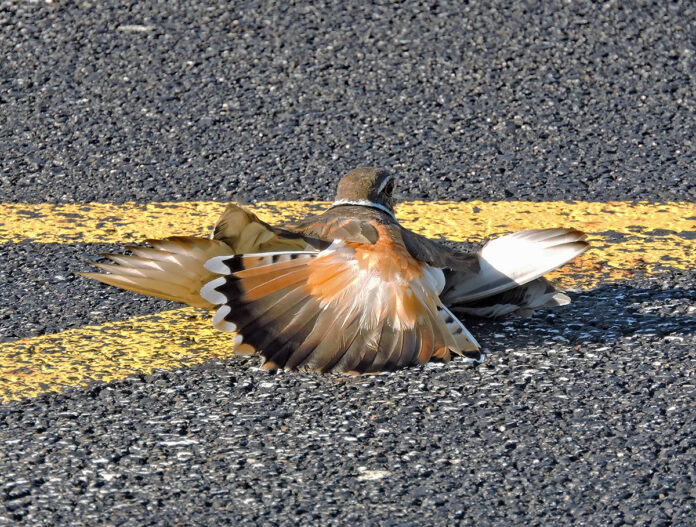
Chances are it’s happened to you. While walking down a driveway or gravel road, suddenly, there is a good-sized bird ahead of you on the ground. It flops around from side to side, flailing its wings while spreading its tail wide, revealing a striking rusty-orange rump. The entire time it is uttering the most pathetic chittery trills. Poor bird! It is obviously in some sort of distress. You take a couple of steps in its direction. Then a few more. As you begin to close in, amazingly, the bird pops up and flies about 30 feet away and resumes its struggle. Completely captivated, you once again head in its direction. As the bird sees you approaching, its struggle intensifies, holding your attention. You continue your advance. Again, at about 15 feet, it amazingly recovers just long enough to escape your reach and begins the behavior again. One more time the scenario plays out and this time, as you get close, the bird simply up and flies away leaving you scratching your head. Some of you will lose interest before this final act, while others will catch on to what the bird is doing and chuckle at their mistake. Suffice it to say, the bird is a darn good actor!
Killdeer

Meet the killdeer, (Charadrius vociferus) a robust plover and member of the shorebird family. Measuring up to 11 inches in length with a wingspan of nearly 20 inches its hard not to miss this handsome specimen with its long, fleshy legs and a black bill. Perhaps the most obvious field marks are the two broad black bands stretching across its white breast. A cryptic mix of brown, rust, black and white feathers, the bird reveals a striking orange rump when in flight. If you can get close enough, you will see a fleshy red ring around the eye, which intensifies in color during the breeding season. But the most recognizable characteristic of the killdeer is its sharp two-part call, “kill-deer, kill-deer”, from which its name is derived. Often this call can be heard throughout the night, as the bird is active anytime of the day.
Although it is a shorebird, the killdeer spends a good amount of its time on dry land. It prefers areas with low or no vegetation such as pastures, driveways, parking lots, golf courses and even rooftops, feeding on small invertebrates associated with these habitats. It’s an opportunistic feeder, dining on grasshoppers, flies, beetles, spiders, snails, crayfish and even seeds. Often, it can be seen following the plow and plucking earthworms from the freshly turned soil.
Breeding season

Here in northeast Ohio, the killdeer commences breeding season in mid-April. Its nest is constructed on the ground, out in the open. A shallow scrape or depression is formed into the soil measuring up to 3.5 inches across. Small pebbles and bits of dry grass make up the structure which usually lies between conspicuous blades of grass. The handsome eggs are beige-colored with dark markings and blend perfectly into their surroundings. A clutch of four to six is common and incubation is shared by both parents, typically lasting anywhere from 22 to 28 days.
Killdeer chicks are unique, as they are precocial. Unlike other songbirds, right out of the shell, they are fully feathered in down, their eyes open. They leave the nest just one day after hatching, the parents leading them into areas of dense, sheltering vegetation. For the next 30 days, the adults remain with their chicks, teaching them how to forage and survive until they attain full flight. Often, they will produce a second clutch of eggs and will even nest up to three times in a season.
Injury feigning
Because of its close association with humans, the killdeer is one of the most successful of all shorebirds. Obviously, placing your nest on the ground doesn’t afford much protection. In fact, over 50% of killdeer nests fall victim to predation, including raccoons, skunks, opossums, crows and canines.
Yet, Mother Nature has provided the bird with an amazing form of nest protection in a behavior known as “injury feigning.” Should a predator draw too close to a nest, the killdeer will launch into an incredible display, rolling around on the ground and faking an injury while sending out audible distress calls. The predator is drawn to the “injured” bird which steadily draws it farther and farther from the location of the nest. When it feels that the marauder is far enough away, it flies off, calling out as if to laugh at the animal’s mistake. When you nest on the ground, completely unprotected from predators you’d better have a darn good strategy for deterring them. The killdeer is by far one of the best performers in the animal world, surely a class act.
















Tami, we once had a construction site where one of these critters decided to make a nest. We placed poles with flags around the nest to keep construction activities at bay. The chicks are totally adorable – think a golfball -sized cotton ball with 2” stick legs and a beak. They run like a deer ( no one there was fast enough to ever catch one)! We currently have 6 in our new corn field.